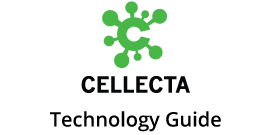Both genomic DNA (gDNA) and mRNA are commonly used as starting material for immune receptor profiling, and each has advantages and disadvantages. Cellecta offers both an RNA-based and a DNA-based AIR profiling assay. The choice of starting material depends on the sample type and downstream applications of your experiment.
The AIR RNA assay provides the following advantages:
- Sensitivity: The copy number of mRNA per cell is at least 10 to 100-fold greater than gDNA, significantly increasing sensitivity due to the higher number of starting RNA template copies [4]. The increased AIR sensitivity from using RNA templates is an essential advantage for reliable profiling of TCR and BCR clonotypes in small biological samples (e.g., sorted cells, tumor biopsies etc.) (Fig. 13).
- Functionality: Using RNA as a template limits amplification of only the receptor chains which are functional and productively expressed. AIR profiling from gDNA amplifies many additional sequences, including non-rearranged and rearranged but non-functional (usually expressed at low level) receptor genes, which increases undesirable background in the NGS data, especially in tissue samples with low immune cell content.
- Coverage: BCR repertoire analysis using gDNA as a template does not allow identification of the Ig isotype (IgG, IgA, IgM, IgD, and IgE), as V(D)J and C regions are separated by an intron and cannot be effectively amplified by a multiplex-PCR reaction. Furthermore, to study somatic hypermutation in immune cells, RNA allows a better coverage of the full-length CDR1-CDR2-CDR3 region.
The drawbacks of using RNA include requiring reasonable RNA template integrity (RIN > 5). Furthermore, if your research needs to accurately quantify the T and B cell number for each clonotype, a gDNA-based assay with VBCs (Cellecta AIR DNA assay) or in combination with spike-in control calibration standards is a better choice.
The AIR DNA assay provides the following advantages:
- Stability and Sample Quality
DNA is more stable than RNA, making it easier to work with in various experimental conditions. DNA-based immuno-repertoire construction requires lower sample quality compared to RNA-based methods, facilitating easier sample handling and storage. This stability is particularly beneficial when dealing with challenging sample types or in situations where optimal storage conditions may not be available such as FFPE samples and tumor biopsies.
- Accurate Cell Count Representation
Each cell contains only one successfully rearranged V(D)J gene. This allows accurate measurement of the actual number of cells in a sample. This provides a more robust representation of the cellular composition of the immune repertoire, which can be crucial for certain applications such as cell tracking in hematologic malignancies (Myeloma, Leukemia etc.)
DNA-based assay is not as sensitive as RNA-based assay due to a high expression of RNA on the cellular level and thus requires a higher input amount of starting material (eg: 1-2 ug of DNA). Therefore, if the goal of the study is to find rare clonotypes, RNA is a better choice than DNA. Moreover, if the goal of the experiment is the detection of up-regulated or activated disease-associated clonotypes (similar to differential gene-expression analysis) then RNA is recommended.
Identification of disease-activated CDR3 clonotypes
The most common strategy for discovering antigen-induced clonotypes is AIR repertoire profiling in multiple samples collected in serial / time-course studies of infection, immunization, immune therapy treatment, etc. [1-5]. Antigen-activated clonotypes are detected by an increase in the copy number of RNA or DNA CDR3-specific sequences compared to control or non-activated samples.
In another application, the identification of overlapping, transcriptionally activated CDR3 clonotypes in the tumor, blood, or tumor-draining lymph nodes can be used for identifying tumor-reactive T cells [24]. Unfortunately, for many human diseases, only a single sample (e.g., a heterogeneous tumor biopsy) is available for AIR profiling.
Studies demonstrate that adaptive immune activation induces significant up-regulation of both BCR and TCR transcription in antigen-specific clonotypes (e.g., up to 1,000-fold for plasma B cells [13]) as illustrated in Fig. 13. Furthermore, the transcriptional up-regulation of TCR genes in large CD8+ effector memory clonotypes in peripheral blood samples was associated with durable responses to immune checkpoint blockade in patients with metastatic melanoma [23].
As a result of transcriptional activation, an RNA-based immune receptor repertoire is usually dominated by a low number of abundant clonotypes, some of which are antigen-induced or disease-specific. Up-regulation of TCR and BCR receptor gene expression in activated effector/memory T and B cells can identify and differentiate antigen-induced CDR3 sequences from non-activated, bystander CDR3 sequences commonly present in tumor samples [20].

Combining mRNA and gDNA-based assay technology
A simple and efficient strategy to differentiate antigen-induced clonotypes from abundant naive or bystander clonotypes commonly present in clinical samples is to normalize RNA-based CDR3 profiling to similar data from a DNA-based assay. To facilitate this approach, we developed VBC-based AIR-RNA and AIR-DNA assays, which may be combined to identify antigen-activated clonotypes.
As a practical guideline, we suggest that AIR profiling be performed using both RNA and DNA isolated from the same biological sample (e.g., PBMC with high content of immune cells). In another approach, RNA-based and DNA-based AIR profiling could be performed directly in T and/or B cells sorted from tissue or blood samples (see below). Furthermore, to reveal disease-associated, activated CDR3 clonotypes, RNA-based data can be normalized to DNA-based AIR profiling data for overlapping clonotypes, as illustrated in Fig.14.
![Fig 14. Comparison of RNA-based to DNA-based immune receptor repertoire profiling data from RNA and DNA purified from the T and B cells sorted from metastatic brain tumor samples [20]. Results show the presence of 5-10% tumor-activated immune receptor clones (marked by brackets) that can be activated by up to 1000-fold (B cells) and to 50-fold (T cells) by transcriptional activation of immune receptor genes.](https://manula.r.sizr.io/large/user/8969/img/dna-rna-2.png)
Need more help with this?
Contact Us

